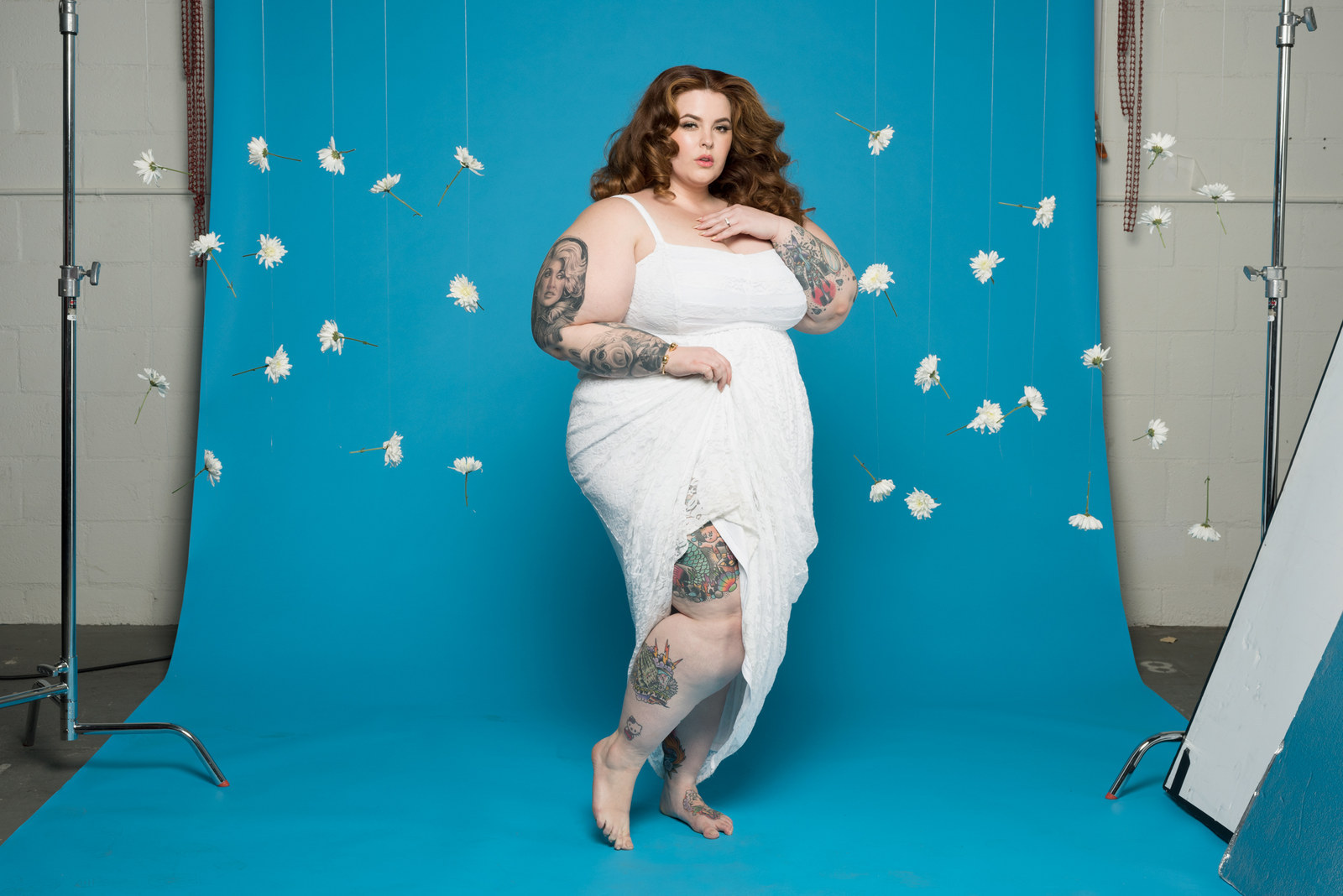Her real name is Ryann Hoven, but I won’t know this until much later, when we’re a couple drinks in at a tiki bar older than time. When we meet she’s Tess Holliday, plus-size model and social media phenomenon, and she’s sitting with her fiancé and her stylist in her stylist’s Burbank, California, apartment with clips in her auburn hair. “We have an issue,” she says as soon as I walk in.
Her apartment manager Terri just called. Terri needs to get to the doctor — something about emphysema and juniper bushes — but she’s stuck out in Pasadena with no ride and no cash, and there’s been some kind of insurance snafu.
Holliday has a photo shoot at BuzzFeed’s Hollywood studio in two hours, before which she needs to be transformed into Venus, the Roman goddess of sex and fertility. Her fiancé Nick Holliday (she’s been using his last name professionally since January) is from Australia and can’t drive. There’s talk of Ubers, traffic, routes, and other logistical schema.
“Let’s just go,” she says, and within seconds she’s out of the chair and hair clips are flying. Because sometimes Holliday is a savior, despite her best intentions. She’ll grab her keys, her fiancé, and the reporter she met two minutes ago, and she’ll take a woman to the doctor, modeling career be damned.
Earlier this year, Holliday became the first woman of her size to sign with a major modeling agency. It’s a dubious sort of record in a culture obsessed with thinness, in an industry that feeds that obsession. The announcement brought Holliday international media attention and jobs with companies like Torrid and U.K. brands Yours Clothing and Simply Be. It also let loose a deluge of scrutiny over her body and her health, all of which Holliday dismisses.
“People should just mind their own fucking business,” she says as she speeds toward Pasadena in her red Toyota Yaris. The car’s dominant theme is Hello Kitty: steering wheel and seat covers, decal, rearview mirror charm.
For the record, Holliday is 5’3½” and wears a size 22. She eats what she wants and exercises when she has time. She doesn’t care if you think she’s healthy, or beautiful (see her #EffYourBeautyStandards campaign). She doesn’t care whether you call her plus-size or curvy or any other euphemism for “fat.” You can also just call her “fat" — it’s OK.
“The reality is I am fat. It’s a word. It’s an adjective. And I don’t care.”
Holliday takes a call on speakerphone from her friend Nadia Aboulhosn, who’s also a model.
“They want me to do the photo shoot and do three posts for them, and I told my agent they’re nuts,” says Holliday.
“Three posts? OK, no. Do one post and a photo shoot,” says Aboulhosn. “And you can also throw in a behind-the-scenes on Instagram.”
Holliday makes a wrong turn down an alley under the highway and pulls a U-turn while holding her phone.
“Let me let you go because I’m on my way to get my friend to take her to the hospital and I’ve got a journalist in the car with me right now,” she says. “FaceTime me later.”
Holliday was discovered on social media — a fairly recent trend in the modeling world. What started with a Myspace account is now a platform with 650,000 followers on Instagram; 820,000 people have liked her Facebook page. And it’s no secret that this online following is responsible for her success.
“I’d never scouted someone like that before,” says Anna Shillinglaw, founder and managing director at MiLK Model Management, who stumbled on a photo of Holliday one night while scrolling through Instagram. She thought Holliday was “a cool size with an incredible face.” And, Shillinglaw adds, “She had more social media stats than all the top plus-size models put together.”
Holliday has complicated feelings about her online popularity. “I want to get jobs because of my ability and not rely on social media for validity,” she says. Understandable, if also a bit idealistic. “Making it” used to be about the people you know; now it’s about how many people know you.
We squeeze into an exam room, the three of us and Terri, a 65-year-old riot of a woman in black spandex leggings and a blonde bob who thinks I work for a news outlet called BugFeed. Holliday looks younger than in photos. With a good pout and perfectly arched brows, she bears more than a little resemblance to Marilyn Monroe. And I promise this is a compliment — she has one of the most gorgeous resting bitchfaces I’ve ever seen.
“I don’t want you to be late, honey,” rasps Terri from the exam table. Her birdlike legs dangle above the floor.
“What am I going to do, leave you to die?” says Holliday. “I don’t care about the photo shoot.”
After about an eternity, the doctor wheels in what looks like a portable record player but is actually some kind of breathing machine that makes a sound like a jackhammer while Terri sucks air through a plastic mask. She keeps moving the mask to tell me about Holliday.
“You see how bighearted she is?”
SUCK
“She’s the best.”
SUCK
“I’m so proud of her; I really am.”

We get Terri squared away with her doctor’s bill and her prescriptions — Holliday pays for everything — and we drive back to Burbank to finish the goddess curls. Holliday inspects a chin pimple in the rearview mirror. “I can’t wait to get my makeup on,” she moans.
When I talked to Shillinglaw, she alluded to a secret project with photographer David LaChapelle and told me to expect to see Holliday in the glossy high-fashion magazines. If there were ever a time to believe a paid hype person, it may be now. The fashion industry — that immovable rock barring the road between the beautiful and the rest of us — is showing signs of, well, moving.
Some of it is trickle-down from the entertainment industry, where women of diverse sizes are dominating these days. There’s Mindy Kaling on the cover of InStyle, Melissa McCarthy on Elle, Lena Dunham on Vogue, the Broad City ladies in a glam photo spread for Vanity Fair. Some plus-size supermodels have launched careers abroad, like Robyn Lawley, the first plus-size model to appear in Vogue Australia or any issue of GQ (see her November 2013 spread in GQ Australia). She became a Ralph Lauren model and made it into this year’s Sports Illustrated’s swimsuit issue. The runway is changing shape too. In April, France voted to ban models under a certain BMI. Denmark’s Fashion Ethical Charter now requires health screenings for every model and “healthy food” at shoots.
Despite all the media attention she’s getting, Holliday is still modeling almost exclusively for plus-size brands. This is probably because of her size. The mainstream fashion world might embrace Lawley, who’s reportedly a size 12 (smaller than the average American woman), but Holliday’s body is still an anomaly in her field. “Past a size 18, there’s no one besides me,” she says. “There’s not an 18, there’s not a 20, there’s not another 22.”
Not that she’s complaining: “I literally have accomplished my wildest dreams,” she tells me in the car.
And there’s plenty of work for her right where she is. There are more plus-size clothing lines than ever before. Major retailers like Forever 21, Target, and ASOS have all launched plus-size labels of their own. Rivkie Baum, founder of SLiNK, a plus-size magazine based in the U.K., said the customer base has always been there, but women didn’t always feel like they had a voice. “We had to make noise in order for brands to take notice,” she said. “Brands used to tell customers what to wear. Now brands are using social media to find out what people want.”
Plus-size clothing has been around since the 1920s, when a maternity-clothing company called Lane Bryant started marketing “Clothing for the Stout Woman.” But the term “plus-size” didn’t catch on until mid-century. “The plus-size woman who wistfully follows willowy mannequins through the pages of fashion publications will no longer have to do without French couture fashions,” wrote the New York Times in 1964, announcing Lane Bryant’s first couture collection. Press photos for the collection featured thin models wearing smaller versions of the plus-size clothes.
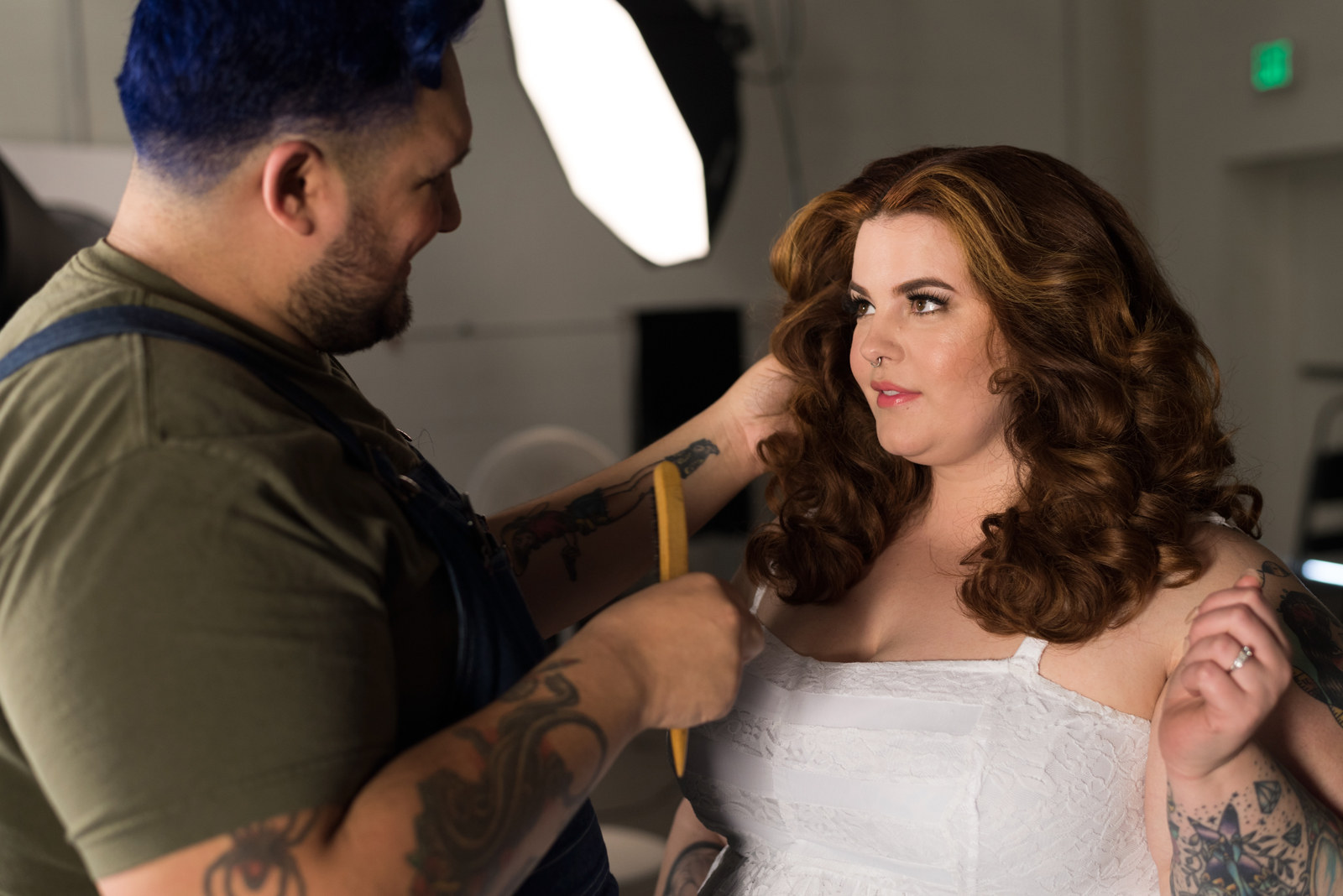
We’re an hour and a half late to the shoot, which feels like an accomplishment given the morning’s turn of events. The studio is a cavernous garage. Holliday’s makeup artist sets her up in one corner, under an interrogation-bright light. Mariah Carey’s "Fantasy" plays tinnily from a laptop on the other side of the room. Americans have just discovered the MyIdol app, and everyone is obsessed. Holliday shows me one her friend sent of her friend’s cat on the stripper pole. It’s mesmerizing.
The growth of the plus-size industry has sparked some backlashes. A recent viral campaign #DropThePlus is calling for the fashion industry to banish the term “plus-size” altogether. “It is ‘harmful’ and ‘damaging’ to the minds of young girls to call models ‘plus’,” wrote Stefania Ferrario, an Australia-based model and co-founder of #DropThePlus, on the campaign’s Instagram. “Let’s #droptheplus in ‘plus size’ altogether and stop labelling women’s sizes, it only causes confusion and segregation.”
“Nick!” Holliday says, looking around. “She’s asking about #DropThePlus.” She wrote up notes because it’s such a touchy subject, but she forgot them. I suggest she just say what she thinks. “I feel like it’s a complete and utter waste of everyone’s time,” she says. “The term is never used in hate; it never has been used in hate. It’s an adjective. I am plus-size. It’s like getting mad that somebody calls me a redhead. I am a redhead.” She says the term is more than a label; it’s a community that accepted her and a lot of other people when the rest of the world didn’t. It’s an identity that has gotten women through abuse and depression — some say it saved their lives.
When I asked Baum of SLiNK, she agreed that arguing about semantics is beside the point. “It’s not like if we got rid of the term [plus-size], those girls would start shooting Vogue or Elle. Those magazines wouldn’t use them because they don’t have the sample sizes to put them in.” The real work, she says, is in getting brands to expand their lines and getting retailers to carry those lines.
Until recently Lane Bryant was considered a respected but dated plus-size brand — the great-aunt who reliably brings coleslaw to the family picnic. But in April the company launched the “I’m No Angel” campaign for its lingerie line — a not-so-subtle jab at Victoria’s Secret. In the ad shot in black and white, six lingerie-clad women vamp in front of a bare wall. “How boring would it be if we were all the same?” asks one seductively.
But the campaign stumbled when bloggers complained that the models weren’t diverse enough. “All of the models have similar, proportional figures, and all of them are around a size 16,” wrote body-positive blogger Amanda Richards. “I don't understand why Lane Bryant can't opt for more diversity in their advertising, given that it's what plus-size women want and what they have been quite literally begging for on social media.”
Holliday thinks the backlash against Lane Bryant is also stupid and that the industry could show more diversity in size, gender, and skin color. But also, she kind of doesn’t care. “I don’t ever really knock people down for trying,” she says. “Could they have tried harder? Yes. But at least they did it.”
The concept for Holliday’s shoot is Botticelli’s "The Birth of Venus." Venus is naked in the painting; Holliday wears a long white dress. An intern grips a floor fan and tilts it to various degrees. Holliday’s hair gleams under the lights. The photographer shoots on counts of three.
I spend the better part of an hour standing next to Nick, who keeps up a steady stream of commentary in my right ear. Holliday really knows how to work the angles, he says. She’s a quick learner, he says. She’s got something special. She’s one of the best in her field.
It’s clear that Holliday, like any model, knows how to flatter her shape. At one point she rejects a suggestion from the photographer because, she says, “I don’t want it to make my tummy look so round.” Her poses aren’t flashy, but there’s something transfixing about the way she moves. It’s like watching clouds — how first they look like one thing then all of a sudden they’re something else, and you can’t tell if they’re changing or you’re seeing them a different way. She holds her dress in one hand. One, two, three, click. Her gaze lowers. One, two, three, click. Her pout deepens. One, two, three, click. Her shoulders go up just an inch. A series of imperceptible shifts and then she’s someone new.
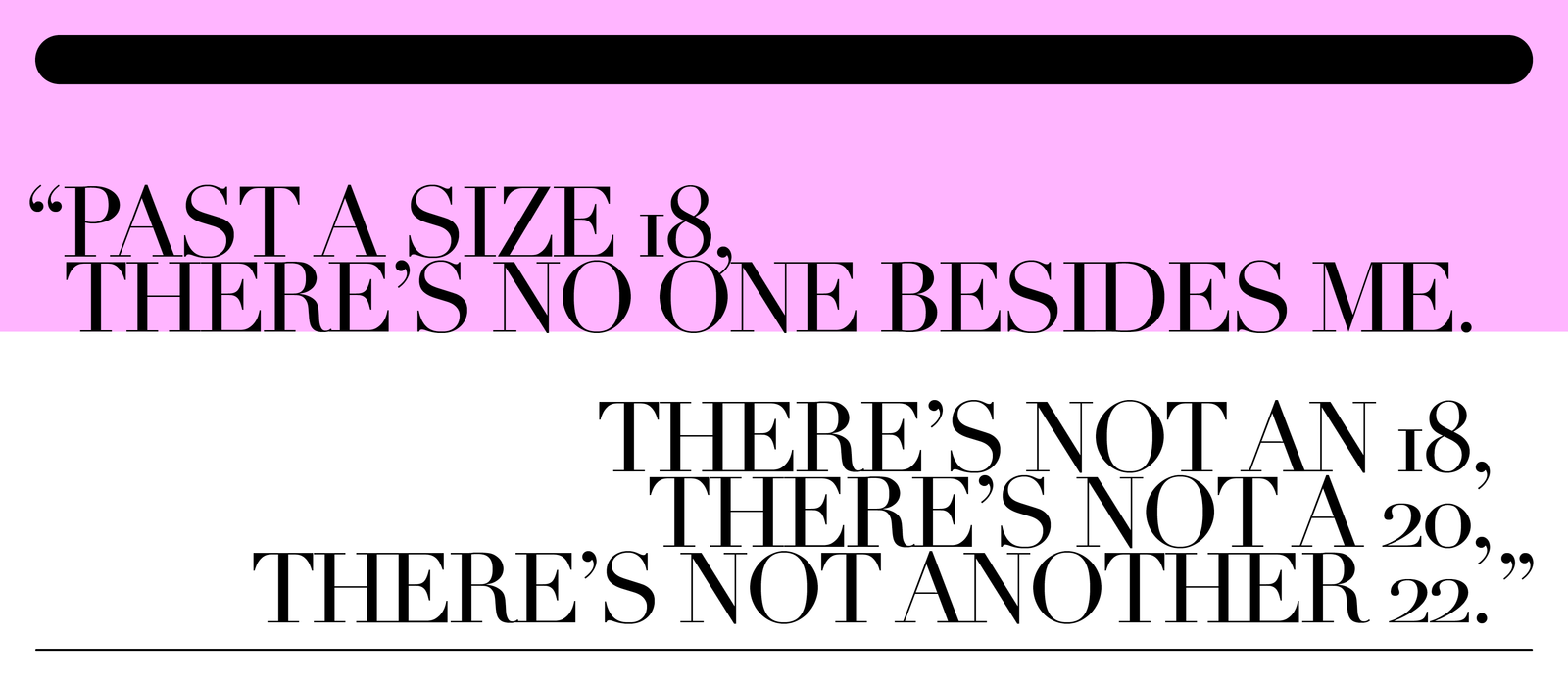
It’s the day after the shoot, and I’m sitting with Holliday on the L-shaped couch in her apartment. She’s just back from the dentist — the same dentist she worked for as a receptionist just a year and a half ago. “I have a fucking cavity!” she tells me, pointing to her bicuspids.
Holliday may be a celebrity model on the internet, but she’s not living like one, at least not yet. We’re in the same one-bedroom that she’s rented since 2010. Her 9-year-old son sleeps in the bedroom; Holliday and Nick sleep where a dining room table might otherwise be. They met three years ago when he complimented her on Tumblr and she wrote back, “My jaw just hit the floor. You’re really handsome.” He moved from Melbourne to be with her. He’s been in the States less than a week. Everything he owns is on a freighter somewhere in the Pacific, months away. Nick doubles as Holliday’s manager. Her stylist is a friend who does hair for proms and weddings. Her personal assistant’s main gig is doing makeup for RuPaul.
But Holliday looks regal today, posed on her couch in a sheer black top and moto leggings, black eyeliner sweeping toward her temples. Her accent carries nothing from the Bible Belt where she grew up, in towns across Mississippi, North Carolina, Florida, Alabama, Georgia, and Tennessee. Her dad would uproot her family without warning, sometimes in the middle of the night. She counts 60 moves in her lifetime, an impossible-seeming number.
Holliday’s life gets called a Cinderella story a lot, which is an understatement when you consider the facts. She delivers these facts with all the emotion of my rental car’s GPS, probably because when you’re 9 and your mother’s boyfriend shoots your mom twice in the head, you become a little removed. And because when middle school bullies taunt you for not only being fat but also for having a paralyzed mom, you disconnect a bit. And when your stepdad sits on your stomach and punches you repeatedly, it’s helpful to stop feeling things.
“You either find some way to deal with it or you let it destroy you,” says Holliday. “I’d seen a few people in my life who let it destroy them. They became shells of people, and I didn’t want to be that person. I chose emotional eating. It wasn’t the best way, but it was all I knew at the time.” She says this as an explanation, not an apology.
Holliday has wanted to model since she was 15. She had a Myspace account where she’d post photos, but she was always told she was too short and too fat, even for plus-size work. She dropped out of high school in junior year and got her GED. She had Riley, her son, when she was 20 and working at a Walmart in Mississippi for $8.50 an hour. “I realized that I needed to get the fuck out of Mississippi. I couldn’t bring him up in that environment. Having him pushed me to fight for what I wanted even more.”
She moved to Seattle with her 1-year-old, three suitcases, a Pack-n-Play, and $700. She didn’t have a car, so she bartered food stamps for rides to the grocery store. She worked as a bank teller and in a dental office making $15 an hour. In 2010 she moved to Los Angeles for a man she’d met on OkCupid. “I didn’t move to be a model,” she says. “My plan was to live with my partner at the time, have a family, and go to makeup school.”
Then, out of nowhere, she got hired to be the face of the A&E show Heavy. The casting director found her through a ModelMayhem.com profile she’d created using the pseudonym Tess Typhoon.
“It was such a big moment. My face was on a billboard on Sunset Boulevard.” On a bet with a friend, she created a Facebook fan page as “Tess Munster” because she liked The Munsters (“That’s pretty much all the brainpower that went into that name”). Small jobs trickled in after that for alternative fashion labels and retro-culture magazines with names like Drive-In, Glam Rock, and The Cat's Meow. Most of these were trade work, done in exchange for publicity and photos. In the modeling trenches, she became whatever she needed to be. She went goth, steampunk, rockabilly, circus carny, ‘50s pinup. She wore skull necklaces, spider hair clips, tutus, and a bra made out of candy.
As Anna Shillinglaw puts it, “She has a face that can make her into lots of different things.”
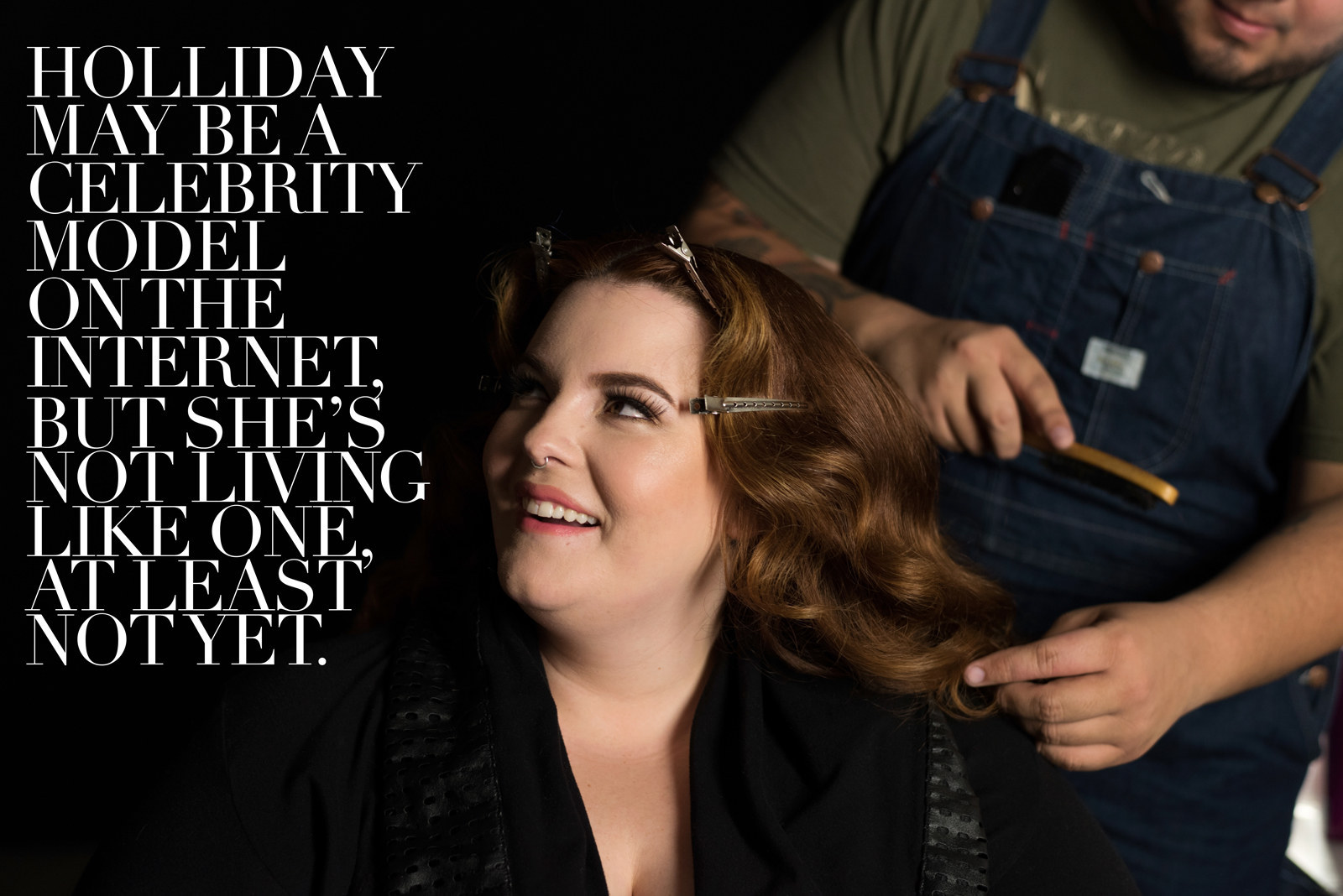
A female social media phenomenon who displays her body for a living is guaranteed catnip for internet trolls. Holliday gets around 1,000 offensive comments a day, she says. She’s gotten death threats in the mail. Her search results on Reddit are too horrifying to discuss.
Fat-shaming dates back to at least the late 1800s, when aristocrats used body weight as a way to distinguish themselves from the lower classes. Now many body-positive activists say it’s one of the last openly accepted forms of discrimination in this country. “Society still thinks that it’s OK to bully people that are overweight, and that by bullying people we’ll lose weight,” says Holliday. If you’re skeptical, imagine a reality TV show like The Biggest Loser except with coaches pushing queer people to become straight.
A 2008 study in the International Journal of Obesity found that people reported size discrimination more often than sexual orientation and almost as frequently as race and age discrimination. Women report more discrimination than men, and at lower body BMIs. Also, incidences of weight discrimination went up 66% between 1995 and 2005, and that’s after controlling for the fact that there are more overweight people than ever before.
But more interesting are the comments from concerned cybercitizens, people who think they have her best interests at heart. They say things like, “If you love yourself, don’t you think you should take care of yourself?” and “I want her to change her lifestyle so she can live comfortably” and “I love that you advocate acceptance and positivity but you’re also advocating an extremely unhealthy lifestyle.”
“We’re seeing more ‘fat bodies’ in our mainstream media," says Jes Baker, a body-positive activist who runs the blog The Militant Baker, "but the caveat is that they must be healthy.” According to Baker, healthy living is such a dominant trend that people treat it like gospel. They let it govern every aspect of their lives — which products they buy, what food they eat, what they do in their spare time. And it frames nearly every conversation we have about weight. A century ago, people were panicking about the obesity “parasite.” Today it’s an “epidemic.”
There’s plenty of debate about whether weight determines health and health determines weight, but activists like Baker say that’s beside the point. “There are so many dollars put into teaching people that health is everything when it comes to somebody’s worth,” she says. “Is it good to take care of our bodies and treat them well because we love them? Yes. But our actions there really don’t impact our worth as a human being.”
Or, as Holliday puts it, everyone has their vices; hers are just easier to see. “Some people smoke pot to make them feel better. Some people drink a fucking bottle of wine. Some people get a million cats. Who’s to say which is more damaging?”
People love to accuse Holliday of celebrating obesity, which, in a way, she is. She refers to a body-positive meme that gained popularity last year: “How to get a bikini body: Put a bikini on your body.”
“I want to show people that it’s OK to be in a bigger body, feel sexy, and not feel ashamed,” she says. As Baker and other body-positive activists see it, a happy fat woman like Holliday is not only an anomaly, but she’s also a threat to our long tradition of telling women what to do with their bodies. She’s a threat to a system that survives by selling happiness and health. In this light, Holliday is doing something very radical by saying she doesn’t care.
In February, Holliday sat in front of a studio audience while talk show host Meredith Viera tried to make her cry.
“Did you worry about that when you decided to put your image out online,” Viera pressed, "that, ‘Oh my god, I’m going to magnify the bullying’?”
“No,” said Holliday emphatically. “Because I was trying to live my dream. Who would think that someone would criticize me for wanting to be myself?”
Maybe this is naiveté, maybe it’s denial. Or maybe it’s the mind-set of someone who’s still figuring out what it means to be in the public eye. After all, it took Holliday a decade to book her first modeling gig. As she puts it, “That’s a lot of time. That’s a lot of people not giving a fuck.”
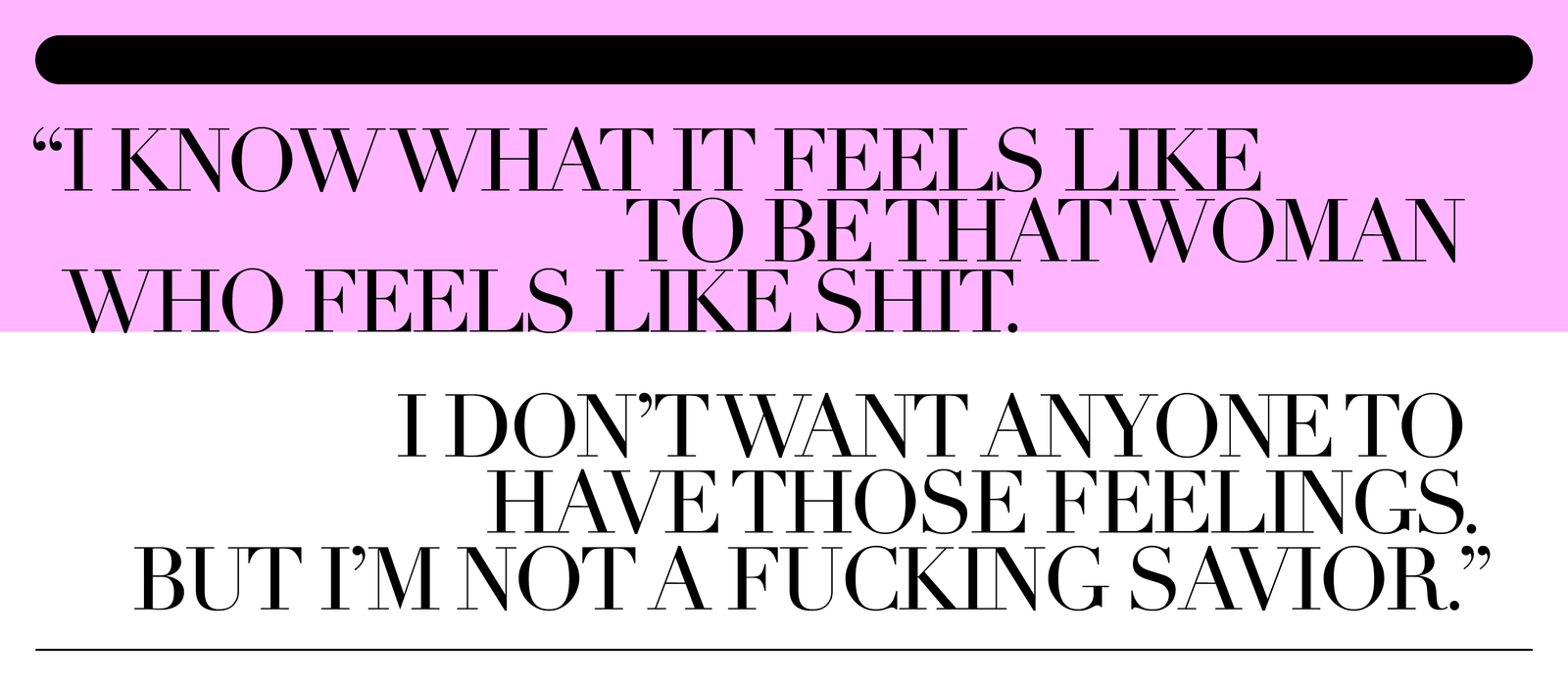
We’re in that tiki bar older than time, in one of those Eastside neighborhoods that New Yorkers like to refer to as the Brooklyn of L.A. Holliday sips a rum cocktail and nuzzles Nick’s neck. She takes selfies peeking out from behind his beard. She bets me I can’t find her real name on the internet, then she tells me what it is anyway. She talks about Disneyland (“Nothing is cheesy and everything is thought of”) and clit pics. I’ve never heard of such pics but I think I get it.
“I never would’ve taken nude photos or walked around the house naked a couple years ago,” Holliday tells me. “The only way I felt sexy was when I was in shapewear or corsets and had an hourglass figure in a tight dress.”
In a speech last year, she said dating Nick is what made her feel sexy for the first time: “Having him push me to be naked in front of him, in bad lighting, having him worship every curve on me, the smooth and the bumpy.” It’s not what I expect to hear from a body-positive icon, that it took a man to make her feel beautiful in her skin. It seems to contradict the fierce independent streak she’s fostered since she was a kid.
“So is it hard to just, you know, be in love?” I ask. “When you’re still fighting for your career?”
She doesn’t take my bait. “For so long I was so used to looking out for myself and no one really caring about me,” she says. “But the most important thing for me was to find love. What does it matter if you’re doing all the stuff and you have nobody to share it with? If everything was gone tomorrow I would be fine.”
When she talks about the future, she talks about getting married, moving to a nicer place, having more kids. In other words, some stability, finally. For Tess Holliday, born Ryann Hoven, formerly known as Tess Munster, formerly known as Tess Typhoon, this might be the biggest reinvention yet.
A 30ish-year-old woman in a full skirt walks over from the bar and earnestly introduces herself and says, “I wish I had someone like you to look up to when I was in high school."
Holliday is demure. When the woman leaves, Nick tells me this happens all the time. “They shake and they cry. It’s quite odd,” he says.
“If it wasn’t for my following, I wouldn’t be working,” she says. “I’m very grateful to them.”
They approach her at bars, they fly across the country to meet her. They show up, 900 strong, at the meet-and-greets she holds every couple months. They even get her face tattooed on their bodies. Holliday tells me her first thought when she sees the tattoos is "I really hope I don’t piss you off."
She has faces on her body, too — Mae West, Miss Piggy, Marilyn Monroe, Dolly Parton — but these women are unimpeachable. They’re dead or cartoons or they have their own theme park. Holliday is a 29-year-old with a cavity who remarks, upon leaving the bathroom, that it “smells like something died” coming out of her, and put that on the record please. She’s in a tough spot right now, trying to not giving a shit what people think, trying to be everything her fans expect her to be.
“I do feel the pressure,” she says. “It’s a lot when you log on and see somebody saying, ‘The first thing I do every day is check your Instagram before I get out of bed.’ You can’t put all your happiness on someone like that. They’re just going to disappoint you.” She says it like she’s been there before.
Holliday gets asked a lot what it’s like to finally be happy with herself, and she still doesn’t have an answer. She doesn’t wake up every morning feeling like a ray of feminist, body-positive sunshine. She’ll still choose macaroni and cheese over a salad most days. And she still eats to feel better sometimes.
“I know what it feels like to be that woman who feels like shit. I don’t want anyone to have those feelings. But I’m not a fucking savior,” she says.
Tess Holliday doesn’t care except when she cares too much. She’s not a fucking savior until she is. For wheezing old ladies; for her son who’s 9 now, wiry and freckled and obsessed with the Ninja Turtles; for the girl with a photo of Holliday on her bedroom wall; for people she’s never met and probably never will. Is she fat? Sure. Does she like Pringles? Hell yes. Does she provide for her son, have sex with her fiancé, and have the career of her dreams? Yes to all that too.
She orders a drink called the Ooga Booga, and the whole bar starts chanting, “OOGA BOOGA, OOGA BOOGA,” because this is apparently a thing. Holliday surveys the crowd from her seat in the corner — men smoking cigars, Abercrombie & Fitch–like blondes, washed-out actor types — and smiles. It’s almost like they’re cheering for her.
